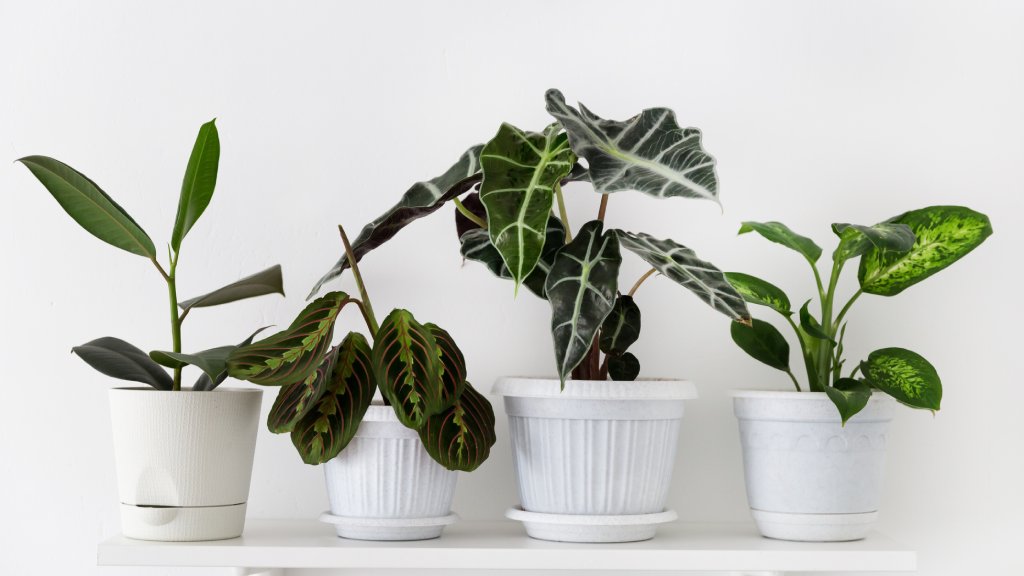Do Indoor Plants Improve Air Quality? What The Scientists Say
We’ve heard about snake plant oxygen and indoor plants that improve air quality. They may help some, but there’s more to know about the studies.


Plants can be beautiful, vibrant, and can even have personalities. But can they improve the quality of air in your house? In 1989, a NASA team published their findings about how certain common houseplants remove toxins from the air. But does this mean that keeping indoor plants will improve the air quality in your house? Do air-purifying plants really work? It’s complicated and the evidence available is far from conclusive.
Do Indoor Plants Really Improve Air Quality?
Most people who keep houseplants come to love them. Their lush foliage is both elegant and cheerful, and studies suggest that indoor plants can improve concentration and productivity, lower stress levels and improve your mood. But one of the most talked-about benefits of keeping houseplants is their supposed ability to purify the air you breathe.
It’s wonderful to think that keeping indoor plants can clean toxins from the air. What better, more natural way to purify air than with healthy houseplants? But do indoor plants improve air quality? Or is the NASA story a myth?
The Oft-Quoted NASA Study
NASA is the agency concerned with getting and keeping astronauts into space. The initials stand for National Aeronautics and Space Administration. One thing that NASA scientists study is how to make space travel safer and more comfortable.
A recent NASA study tested whether specific houseplants can act to purify the air in a closed space. Their study concluded that some common houseplants did in fact reduce the amount of household toxins in the air. For example, the study found that snake plants, also known as mother-in-law's tongue, took out a part of the trichloroethylene, benzene and formaldehyde in a sealed chamber over 24 hours.
The NASA study has been much discussed on social media and in the news. We even have articles on it. As the discussions progressed, the findings have often been exaggerated or misinterpreted. Some have reported that the study determined that snake plants can produce enough oxygen to keep a person alive in an area with no airflow. But the NASA study did not mention oxygen production at all, or any snake plant/oxygen connection allowing survival in an oxygen-deprived environment.
Controlled Environments vs. Reality
Even when the NASA study’s findings are stated accurately, many scientists urge plant owners to distinguish between the controlled environment (sealed chambers) and their house or office. The “real world” is very different from the laboratory conditions in which the study was conducted. Though plants were found to be capable of removing volatile chemical toxins from the air in the sealed chamber, this may not have much to say about the effects of plants in a home.
Gardening tips, videos, info and more delivered right to your inbox!
Sign up for the Gardening Know How newsletter today and receive a free copy of our e-book "How to Grow Delicious Tomatoes".
The NASA studies often involved placing a single potted plant into a small sealed chamber. They injected a single volatile organic compound and tracked it over time to see when it decayed. Moving from a sealed container to a more open environment would inevitably change the dynamics. In many houses, a lot of air comes into and out of a house every hour. This air exchange means that air with toxins is naturally moved out as outside air comes in, resulting in a greater air-cleaning result than any effect the houseplants will have.
It’s also important to remember that, in the NASA study, the plants at issue were exposed to sufficient sunlight to maximize photosynthesis, which improves the plant’s air-cleaning abilities. Although you may try to give your houseplants the best placement possible, it is unlikely that the light available will be equal to that provided in the study.
So, Do Air Purifying Plants Really Work?
What, then, is the bottom line on these issues? Do your plants really purify the air? Can we use snake plants and Boston ferns to combat air pollution? Sadly, we probably cannot count on plants to strip toxins from household air. But their many other excellent qualities are more than enough to justify buying them and taking care of them.

Teo Spengler is a master gardener and a docent at the San Francisco Botanical Garden, where she hosts public tours. She has studied horticulture and written about nature, trees, plants, and gardening for more than two decades. Her extended family includes some 30 houseplants and hundreds of outdoor plants, including 250 trees, which are her main passion. Spengler currently splits her life between San Francisco and the French Basque Country, though she was raised in Alaska, giving her experience of gardening in a range of climates.
-
 Zinnias On Repeat: 10 Glorious Cut-And-Come-Again Varieties For Endless Summer Bouquets
Zinnias On Repeat: 10 Glorious Cut-And-Come-Again Varieties For Endless Summer BouquetsThese zinnia varieties keep giving all summer, making them the perfect choice for dedicated cutting gardens – or just the occasional homegrown bouquet.
By Ellen Wells
-
 Create A Romantic Garden Straight Out Of Bridgerton: Regency Era Romance In Your Garden
Create A Romantic Garden Straight Out Of Bridgerton: Regency Era Romance In Your GardenTry some romantic garden ideas straight out of Bridgerton. Flowers and gardens in the Regency era were lush and charming and you can get the same look!
By Bonnie L. Grant